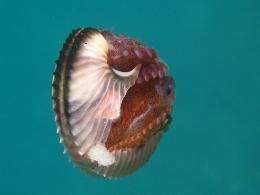Argonaut mystery solved, says scientist

Scientists said Wednesday they had cracked the mystery of the paper nautilus, the brittle and translucent shell belonging to rarely-seen species of open-water octopuses called argonauts.
For centuries, biologists have puzzled over the evolutionary function the female's delicate off-white casing, which is too thin to offer protection from predators.
The most widely-held view was that it served as a brood chamber to house eggs.
But a new study reveals its primary role is to allow the animal to ascend and descend in the ocean by using trapped air to regulate depth.
"Through underwater observations of wild argonauts, we discovered the five-step process by which females gather air from the water surface and transport it to depth, where neutral buoyancy is attained," said Julian Finn, a researcher at Museum Victoria in Melbourne, co-author of the study.
The finding puts the lie to a long-held belief that pockets of air inside the shell had caused the mass strandings of the creatures on beaches around the world.
"This study demonstrates that air in the shells of female argonauts is not only beneficial, it is essential," Finn said in a statement.
Argonauts determine the depth at which they can remain suspended by adjusting the amount of air they "gulp" at the surface.
As an octopus swims to depth using a kind of jet propulsion, the increasing pressure of the water gradually reduces the volume of the captured air -- and thus its buoyancy -- until it exactly cancels out body weight.
Finn speculated that this remarkable feat of controlled equilibrium went unnoticed because previous experiments were conducted in aquariums too shallow for the animals to show off their skills.
His observations were conducted in the wild with specimens captured by Japanese fishermen.
"I took each argonaut scuba diving," he explained. "I removed all the air from each argonaut's shell, released it and observed."
The octopuses immediately jetted to the water surface, where they gathered a precise volume of air and sealed it with their arms before returning to the depths.
Found in all tropical and temperate waters, argonauts are an important food source for whales, seals, fishes, sea birds and other marine predators.
Unlike the chambered nautilus, with which they are sometimes confused, argonauts are true octopuses, with eight arms with suckers surrounding a central mouth.
Females secret the shell -- commonly known as a paper nautilus -- with large webs on their upper pair of arms.
There are four known species, varying in size up to 30 centimetres (12 inches) in diameter.
(c) 2010 AFP















